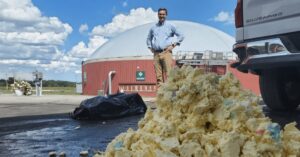The Midwest and the High Plains experienced a mix of drought improvements and degradations over the past week, according to the latest Midwest Drought Monitor. A broad band of rain stretched from Missouri through Illinois, Indiana, and into parts of Michigan, bringing widespread one-category improvements.
https://droughtmonitor.unl.edu/CurrentMap.aspx
Nebraska Avoids Extreme Drought — for Now
Nebraska’s drought conditions have improved considerably in recent weeks, according to the latest data from the U.S. Drought Monitor. As of early June, no part of the state is classified in extreme or exceptional drought — marking the first time since last summer that Nebraska has avoided the most severe categories.
Still, roughly 86% of Nebraska remains in drought: 61% is rated as moderate (D1) and 25% as severe (D2).
https://droughtmonitor.unl.edu/CurrentMap/StateDroughtMonitor.aspx?NE
Eric Hunt, extension educator in agricultural meteorology and climate resilience at the University of Nebraska–Lincoln, described the change as encouraging, but not cause for celebration just yet.
“In places that have seen improvements, but we still have large deficits,” Hunt said.
The concern now for Hunt is timing. With chances of moisture between now and early-July, Hunt believes we can keep kicking the drought can down the road.
“The drought outlook is dryer later in the month. Warm and hot temperatures will exasperate the soil moisture deficits,” he said.
As we look ahead to the reproductive stages, it’s like BBQ, shared Hunt. “You want that meat to slow cook, you don’t want to rush it. It’s the same with the reproductive stage. You want it to stretch out over 50 days. If heat and dryness condense it, corn won’t pollinate properly and if it gets really warm you can have kernel abortion.”
Iowa Holds with Adequate Soil Moisture Ratings
In Iowa, topsoil and subsoil conditions remain relatively strong. According to Madelynn Wuestenberg, Weather and Climate Extension Specialist with Iowa State University:
- Topsoil moisture was rated 70% adequate as of June 1.
- Subsoil moisture was 65% adequate.
https://droughtmonitor.unl.edu/CurrentMap/StateDroughtMonitor.aspx?IA
That’s a solid foundation for early June — but there are areas of concern in the state.
“From a forage and livestock perspective, pond levels are getting low in some areas,” shared Wuestenberg. “Right now we really need some good rain to fill those ponds up. If we look at precipitation from the last two weeks, most of eastern Iowa is at least an inch below normal on precipitation.”
Between June 12-19, most of Iowa is expected to receive a good amount of precipitation. Greater amounts, around 2 inches but up to 4 inches with pop-up showers, are expected in northern Iowa. There’s a gradient as we move south with less accumulation expecting at least a ½ inch. Wuestenberg noted deep-rooted crops will tap into subsoil reserves — especially important as summer evaporation rates rise.
“It’s not quite as much as we’d necessarily like — corn and soybeans typically need 1–1¼ inch per week,” said Wuestenberg. “We do have a warm signal persisting in those outlooks so we are expecting chances for above-normal temperatures in the next couple of weeks.”
After a few weeks of mild temperatures, warmth is on the way and is expected to hang around for a few weeks. Outlooks from the Climate Prediction Center show chances leaning toward above normal temperatures for the 6-10-day, 8-14-day, and 3-4-week outlooks. The 6-10 and 8-14-day outlooks show precipitation chances leaning slightly above normal. The 8-14 day hazards outlook, valid June 19-25, shows a slight risk for extreme heat between June 19-21 and a slight risk for heavy precipitation between June 19-22 in northern Iowa, shared Wuestenberg.
What to Watch Heading Into July
https://droughtmonitor.unl.edu/CurrentMap/StateDroughtMonitor.aspx?High_Plains
Despite a few inches of recent rainfall across the region, we are now entering a season where evaporation rates soar, and daily moisture loss can quickly outpace gains — especially under full sun and high temperatures.
June moisture is helpful, but the timing of precipitation in July and early August is what ultimately makes or breaks a crop, shared Hunt.
Wuestenberg also pointed to longer-term solutions for crop management: building soil health through better organic matter, reduced tillage, or cover crops to improve water retention.


:max_bytes(150000):strip_icc()/FansabovecowsCourtesyofJDManufacturing-da5b90523fc146eb95ac77ad0eadcc34.jpeg)
:max_bytes(150000):strip_icc()/Markets-6-Corn-down-3-a2bcd4ba01644e2cba707afdb7b12d5e.jpeg)



:max_bytes(150000):strip_icc()/50028573847_e980d495b4_o-6625ede4b02740578e9bfb98936e4112.jpeg)
:max_bytes(150000):strip_icc()/WongYuLiang-1498358040-39350a71adf34f7092b0cab33a699279.jpg)

:max_bytes(150000):strip_icc()/13973276071_5d61aaebbc_o-07153824be3147608b38c3330da5b4f8.jpeg)
:max_bytes(150000):strip_icc()/29504wheat_wheat-76d089f12fee4dedad97fe34729468d7.jpg)